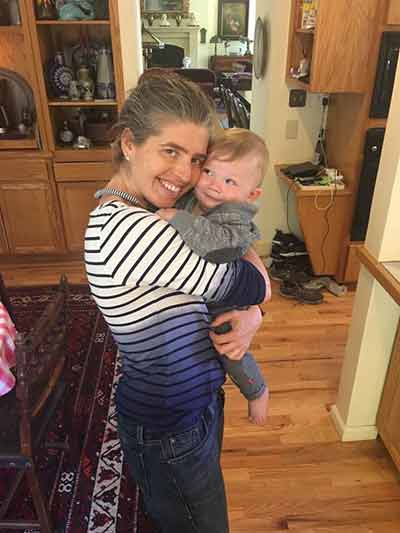
When I became Río’s mom, my dear friend Sarah and I, in the throes of sleeplessness, milk, and diapers, started an ongoing conversation and bond that stays strong and joyful to this day. One of our recurring gags is an ongoing mockery of parenting books, their jargon, pretentiousness, and dogma. In the baby years, it was child-led-this and play-based-that, you know the drill. When we were looking at preschools, we attended open schools about parent-involved-this and developmental that. At some point I quipped that I would become the devout groupie of whatever educational method would get us off the waitlist. We often fantasize about writing a parenting book titled “Do Whatever the Fuck Makes Sense to You.”
But this morning I realized I did, however, come up with some sort of credo. I offer it to you with love on this Mother’s Day, whether you are a mother, a daughter, or both; whether you are near your mother or you miss her; whether she could or could not be fully present for you, in person, in body, or in spirit; whether you’ve had to make hard choices about the timing and form of your motherhood; whether motherly love is easy or difficult for you right now; whether you are mothering a human child, animals, plants, colleagues, friends, students, and/or mentees; in whatever form mothering energy manifests in your life.
1. I see my child every day with fresh eyes.
I wake up every morning to the miracle that this little boy is a member of my family. It is a miracle that he is alive–just as it is a miracle that all of us were babies once. Even when things are hard, there is deep appreciation and love of the opportunity to spend the rest of my life being his mom–and the incredible gift of love from Río’s birthparents, who chose us to be his parents.
2. I am with the journey moment to moment
Neil Gordon’s beautiful article on children and the dharma starts like this:
One night when he was perhaps eight months old, my son woke me, not by crying but by gurgling and laughing. He was in an extraordinary mood. Fully awake, his face broke into a wide smile as I came into his room, his eyes glistening in the glow of the moon above the Brooklyn rooftops. His movements, still uterine, as though he were weightless, were clearly giving him great physical pleasure. And the attention he was directing toward me, the central object of his massive happiness, was as powerful an experience of primal love as I had ever known. Basking in it, stroking my son’s hair, I found a nearly unbearable sensation of regret come over me.
What was it? I asked myself, standing in the moonlit room. Why was such pain attendant on such massive love? The koanic opening line of Yeats’s short poem had long haunted me as an enigma: “A pity beyond all telling/is hid in the heart of love—” koanic because I sensed its truth intuitively, enigmatic because the list of anodynes that followed—regular, everyday occurrences, from markets to clouds—did nothing to explain what that pity was. This night, the poem’s enigma seemed to me more urgent than ever. What is the pity that hides in the heart of love, and why was it overpowering even the magical immediacy of my child’s joy?
Already, I saw, my daughter had transformed from a wondrous baby into a curious, cheerful, intensely imaginative little girl. Already she had friends, interests, secrets. These moments with an infant in a crib—moments stolen from sleep—were likely the last such moments in my life.
I was more right than I knew. My son never again awoke laughing—at least not loud enough to wake me—and soon that eight-month-old face was two years old, then three, and the fat cheeks had smoothed to show my wife’s cheekbones, and the thin baby’s hair had grown into the thick bangs I once had as a boy. And from that night and for a long time after, my experience of my children came to be infused with this pity of love. So much so, in fact, that I thought it was something very like depression. But as I became more versed in this emotion—and particularly as I watched it in my practice of meditation—I became more and more convinced that this pity was not pathological but existential; that there was within it a dharmic insight.
And Mary Talbot writes about awakening to the Four Noble Truths through her children, and awakening them to impermanence and change:
Motherhood—and its corollary, childhood—in their current optimistic models are relatively new historical constructions and haven’t always had such a good rap as pathways to liberation. Until as recently as the 1930s, maternal mortality rates in the Western world were as high as at the time of the American Revolution. And throughout most of human history, infant mortality has been so widespread that well into the 19th century, American parents didn’t name their children until they hit toddlerhood, when the chances for the kid’s survival began to increase. The probability of child death was too extreme to risk developing parental bonds. For anyone who has had a miscarriage or given birth (I’ve done both, twice), fatality feels—is—viscerally close. It’s a painful, perilous business and an ear-splitting wake-up call to the unreliability of this body, this life, these relationships.
Experiencing a child’s life through a parent’s eyes deflates the myth of immortality in other ways, too. Most of us nurse the illusion of having an expansive life because the murky backward stretch of our own childhoods creates a perception of having lived for a very long time. But watching a child grow up explodes that sense of personal timelessness. When my children were in nursery school, I would come across things in the back of my refrigerator that were older than they were. The very phase of life I remembered as stretching out for an eternity was, in fact, over before I could use up a jar of capers packed in sea salt.
Río is now at a phase in which he is upset at time’s one-directional flow. He eats a banana, and then wants it back. I offer him another banana, and he cries: “No! I want the banana I already ate!” A tower of blocks collapses, but he rails against rebuilding, because even if we build a tower that looks the same, it won’t be the same tower that fell down. Whenever we talk about how we can’t bring things back, I see my own grief of impermanence in him–the grief I felt holding one of his baby suits and knowing that he will never be that little again. Thinking about our children’s past (nostalgia) and future (hope) takes us away from the only mothering moment we truly experience–the one that is happening right now. The fourth of the five remembrances in the Upajjhatthana Sutta is, “I must be separated and parted from all that is dear and beloved to me.” A thousand separations happen every day; our children grow more independent; they leave home; they move far away; we quarrel and put distance between us. And all of them foreshadow the last and final separation that death–ours, theirs–will bring. We are assured of this final loss–we cannot prevent it. What we have is now. And it makes now, which is only now–not before, not after, never to come back– precious and special.
3. Through my child, I love the children of the world.
When I started studying dharma and mindfulness, one of the most impenetrable doctrines was the “doctrine of the no self.” But through Thich Nhat Hanh’s Interbeing and through Joanna Macy’s Greening of the Self, as well as through vision quests and journeys, I learned that the separation between the self and the rest of the world is false and malleable. The miracle that is my child is part of the overall miracle of life. Through the joys and pains of my child I feel the joy and pain of other mothers–human and nonhuman alike. It is through this profound understanding that the separation is false that the courage to fight for the life and dignity of all children emerges. Macy interviews ecoactivist John Seed about what motivates his work:
He replied, “I try to remember that it’s not me, John Seed, trying to protect the rain forest. Rather, I am part of the rain forest protecting itself. I am that part of the rain forest recently emerged into human thinking.” This is what I mean by the greening of the self. It involves a combining of the mystical with the pragmatic, transcending separateness, alienation, and fragmentation. It is a shift that Seed himself calls “a spiritual change,” generating a sense of profound interconnectedness with all life. This is hardly new to our species. In the past, poets and mystics have been speaking and writing about these ideas, but not people on the barricades agitating for social change. Now the sense of an encompassing self, that deep identity with the wider reaches of life, is a motivation for action. It is a source of courage that helps us stand up to the powers that are still, through force of inertia, working for the destruction of our world. This expanded sense of self leads to sustained and resilient action on behalf of life.
Working for human rights and for animal rights, for the liberation of life, is part and parcel of being a mother.
4. I let the self grow as it will.
Many of us are in the habit of boxing ourselves in rigid beliefs about who we are: “I’m not the sort of person who…” As our children’s personalities start taking shape, it is tempting to box them, as well. So many preschool admission forms I filled out ask you to “describe your child.” I can describe my child today. I don’t know if the description will fit tomorrow, or even an hour from now; the self is flexible and boundless. I leave room for my child to surprise me every day.
5. I bring the miracle of compassion into my child’s life.
Earlier this year I found myself facing a difficult situation in my law school class that involved some cruel interpersonal behavior between students. As I was contemplating the unappetizing prospect of “giving a stern lecture,” whatever that means, I thought to myself–why would anyone whose empathy muscles are still growing learn kindness, when our government offers so little in the way of role models? But I was also struck with the poverty of cruelty as a go-to approach to the world. Why would you want to experience the small, petty cackle of the small self, when you can laugh with sympathetic joy and embrace with compassion? I don’t know how to “deliver a stern lecture” on that. All I know is that it has to be experienced. So I offer my son as many opportunities as I can to experience what it feels like to be compassionate–from cheering up a sad friend with a handful of blueberries at daycare to rescuing an errant spider from the tub, unscathed, and gently transporting him outside. We talk about our diet and consumption as choices that come from the desire to live as compassionate a life as possible. It is his choice what to take from this to his future life, but I trust that the experience of compassion itself, which is so rewarding, will be palpable for him.
6. I listen first.
There is a phenomenal children’s book I might have mentioned in a post before called The Rabbit Listened.:
I try to be like the rabbit. It is very tempting to superimpose my own interpretation of the situation, but I am not the one experiencing it. My aspiration is to make as much space as possible for Río to sit with what arises for him, without jumping to offer solutions or framing it in some way. I can help with descriptions, which is also an opportunity to learn how to define feelings, but I need to give the feelings as long as they take to process.
7. I let joy and sorrow grow side by side.
Río’s grandparents, who adore him, live far away from us, in Israel. They visit us for weeks at a time, which are times of joy for both Río and them. When it’s time for them to leave, it is very very hard to say goodbye. I insist on goodbyes in person. Feeling the sadness of parting with a loved relative is a gift. It teaches us that we can contain sorrow and grief, that sadness is a part of life, and that we are accepted and loved all the time, not only when we are happy. It has occurred to me that many of us were not given the gift of being allowed to feel sad by our families, and that’s why we don’t know how to pay it forward. It is very difficult to contain the sadness of someone we love. But it is a precious coping skill that I try to nourish from infancy, so that Río learns not to be afraid of the depths; Khalil Gibran reminds us,
Your joy is your sorrow unmasked.
And the selfsame well from which your laughter rises
was oftentimes filled with your tears.
And how else can it be?
The deeper that sorrow carves into your being,
the more joy you can contain.
When you are joyous,
look deep into your heart
and you shall find it is only
that which has given you sorrow
that is giving you joy.
When you are sorrowful look again in your heart,
and you shall see that in truth
you are weeping for that which has been your delight.
Nurturing a great capacity of love also means building a receptive container for the joys and sorrows of life. Offering compassion allows children to develop self-compassion.
8. I open doors to grow.
One of the gifts of adoption is that we don’t automatically assume that our child will have our affinities and interests. He is who he is. It turns out that, by contrast to this bookish/weird parents, Río is a natural athlete who enjoys ball games and skateboarding. Who knew? He might grow up to enjoy going to a symphony concert with me, or he might not, but I open doors to the things that interest us as well as to the things that interest him. Through him, we’ have learned a lot about ball sports and about moving around in ways that were less interesting to us before Río joined our family. I think the lesson can be extended to biological parents as well–our children are vast, open canvasses for the world, and the more doors we open, the more curiosity and exuberance they will find. I acknowledge that the ability to enrich and open doors is largely an accident of birth; because I want all children to grow, not just my child, I work to bring about equality and justice so that other people who love their children and want to open doors for them are able to do so.
9. I build a village.
My friend Ifat Matzner-Heruti, who is a parenting coach, recently wrote on Facebook:
It takes a whole village to raise a child. You are not a village. You can’t be. You can’t do it all, it is simply impossible. You can’t care, and work, and teach, and clean, and cook, and train, and launder, and contain, and listen, and educate, and create, and dance, and jump, and write, and breathe. You are not a village and you never will be. You can’t do it all.
She’s right–and I wrote some thoughts about this a couple of weeks ago. The upshot of it all is that, in the absence of paid preschool or caregivers, I realized that we have an unbalanced life. I don’t need more paid care so that i can work more. I need a shorter workday–we all need that, actually, parents and non-parents alike–so that there is more room to be with my child and raise him. Yesterday, out of the blue, Río said, “I don’t want to go back to the teachers. I want to be with you and Aba at home all the time.” That may not be entirely possible or desirable (and I won’t live with him at his college dorm!) but it conveys a deep, strong sentiment that needs to be honored. Love requires time, and if I don’t have all the time in the world, I want to fill this time with loving extended family, friends, and neighbors.
10. I mother myself.
I apply all of the above to my own life. I appreciate my own present body, mind, and spirit, even as I work daily to grow. I cultivate love for all beings and aspire to put that love into action every day. I listen to myself, I let myself feel sorrow as well as joy with self compassion. I accept the self as malleable and changing and open doors for transformation. And I cultivate a village around myself and my family, at the same time as I aspire to be part of your village.
Happy Mother’s Day to all of you! May your mothering path be filled with love and compassion.




2 Comments
This is lovely. Thank you.
You’re welcome! Means a lot coming from one of the most wonderful moms I know!